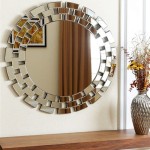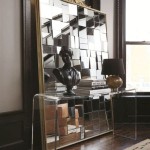Brackets To Hang Heavy Mirrors: A Comprehensive Guide
Hanging a heavy mirror can significantly enhance the aesthetic appeal of a room, adding depth, light, and a touch of sophistication. However, safely and securely mounting a heavy mirror requires careful planning, appropriate hardware, and a sound understanding of weight distribution. The choice of bracket is paramount to the success and safety of the installation. This article provides a comprehensive overview of selecting and utilizing brackets specifically designed for hanging heavy mirrors.
Mirrors, especially larger ones, can weigh a considerable amount. Attempting to hang them with inadequate hardware can lead to disastrous consequences, including the mirror falling and potentially causing damage to property or, more seriously, injury to individuals. Therefore, selecting the right brackets and employing proper installation techniques is non-negotiable.
The term "heavy mirror" is relative and depends on factors such as size and material. A small decorative mirror might weigh only a few pounds, while a full-length mirror or one framed with substantial materials could easily weigh over 50 pounds, or even upwards of 100 pounds. Standard picture hooks or light-duty hanging hardware are simply not designed to withstand such loads. Utilizing appropriate heavy-duty brackets becomes essential for ensuring a safe and long-lasting installation.
Understanding Weight and Load-Bearing Capacity
Before selecting any brackets, accurately determine the weight of the mirror. This is crucial for selecting hardware with an adequate load-bearing capacity. Most mirrors will have a weight specification on the packaging or accompanying documentation. If the weight is not readily available, use a bathroom scale to weigh the mirror. Remember to account for any additional weight from the frame and any decorative elements attached to the mirror.
Load-bearing capacity refers to the maximum weight that a bracket or hanging system can safely support. It is imperative to choose brackets with a load-bearing capacity that significantly exceeds the mirror's weight. A general rule of thumb is to select brackets with a load-bearing capacity at least twice the weight of the mirror. This provides a safety margin and accounts for potential stress factors placed on the brackets over time, such as minor vibrations or slight shifts in the wall structure.
The wall's construction also plays a crucial role in determining the appropriate hanging system. Drywall, while common in residential construction, is inherently weak and cannot reliably support heavy loads without proper reinforcement. Hanging a heavy mirror directly on drywall with standard screws is highly discouraged. Studs, the vertical framing members within the wall, offer significantly stronger support. Ideally, at least one, preferably two, of the brackets should be secured directly to wall studs. If stud placement does not align with the desired hanging location, alternative strategies such as using drywall anchors or installing a horizontal support board must be considered.
Drywall anchors are designed to distribute the weight of the mirror across a larger area of the drywall. However, not all drywall anchors are created equal. For heavy mirrors, use heavy-duty toggle bolts or molly bolts, which provide a robust and secure hold. These anchors work by expanding behind the drywall, creating a much stronger connection point than standard screws. Ensure that the selected drywall anchors are rated for the weight of the mirror, and always follow the manufacturer's instructions for installation.
Another option is to install a horizontal support board, often referred to as a cleat, to the wall. This board is securely attached to the studs and provides a solid backing for the mirror. The mirror is then hung from the cleat using appropriate brackets or a French cleat system. This method distributes the weight of the mirror evenly across the studs, providing a very secure and stable installation. The cleat can be painted to match the wall color or covered by the mirror, making it virtually invisible.
Types of Brackets for Heavy Mirrors
Several types of brackets are specifically designed for hanging heavy mirrors, each with its own advantages and disadvantages. The choice of bracket depends on factors such as the mirror's weight, size, framing style, and the desired aesthetic.
Heavy-Duty D-Rings and Wire: This is a common method for hanging framed mirrors. D-rings are metal loops attached to the back of the frame, and a heavy-gauge wire is strung between them. The wire is then hung over hooks or screws anchored to the wall. For heavy mirrors, it is crucial to use heavy-duty D-rings and thick, strong wire. The wire should be rated for a weight significantly higher than the mirror's weight. This method is relatively straightforward and allows for some flexibility in positioning the mirror. However, it is essential to ensure that the D-rings are securely attached to the frame and that the wire is taut to prevent sagging.
Z-Bar Hangers (French Cleats): Z-bar hangers, also known as French cleats, are a highly effective and secure method for hanging heavy mirrors. A French cleat consists of two interlocking pieces: one piece is attached to the back of the mirror, and the other is attached to the wall. The two pieces interlock, creating a strong and stable connection. French cleats distribute the weight of the mirror evenly along the wall, making them ideal for heavy and large mirrors. They also allow for easy leveling and adjustment of the mirror after installation. French cleats are available in various sizes and materials, allowing them to be suitable for a wide range of mirror weights and sizes.
Mirror Mounting Clips: Mirror mounting clips are small metal or plastic brackets that are attached to the wall and hold the mirror in place. These clips are typically used for mirrors without frames or for mirrors that are flush-mounted to the wall. For heavy mirrors, use heavy-duty mirror mounting clips that are specifically designed to support the weight of the mirror. It is essential to use multiple clips, spaced evenly around the perimeter of the mirror, to distribute the weight and prevent sagging or movement. Mirror mounting clips can be visible or concealed, depending on the desired aesthetic.
Heavy-Duty L-Brackets: L-brackets are metal brackets shaped like the letter "L". They are attached to the wall and provide a shelf-like support for the mirror. L-brackets are particularly useful for mirrors that are very heavy or that require extra support. They can be used in conjunction with other hanging methods, such as D-rings and wire, for added security. L-brackets should be securely attached to the wall studs or to a horizontal support board. The size and strength of the L-brackets should be appropriate for the weight of the mirror. The finish of the L-brackets can be chosen to complement the mirror and the surrounding decor.
Specialty Mirror Hangers: Some mirrors may require specialty hangers due to their unique shape, size, or framing style. These hangers may be custom-designed or purchased from specialty hardware stores. It is essential to consult with a professional installer or a hardware specialist to determine the appropriate hanger for a specific mirror. Specialty mirror hangers may include options for hanging mirrors on doors, on sloped ceilings, or in other challenging situations.
Installation Techniques and Best Practices
Proper installation techniques are just as important as selecting the right brackets. Even the strongest brackets will fail if they are not installed correctly. Careful planning, accurate measurements, and attention to detail are essential for a safe and secure installation.
Locating Wall Studs: Use a stud finder to locate the wall studs in the desired hanging location. Stud finders are electronic devices that detect changes in density behind the drywall, indicating the presence of a stud. Mark the location of the studs with a pencil. It is important to verify the stud locations with a small nail or screw to ensure accuracy. If studs are not available at the desired hanging location, drywall anchors or a horizontal support board will be necessary.
Accurate Measurements: Accurate measurements are crucial for ensuring that the mirror is hung level and in the desired position. Use a level and a measuring tape to mark the location of the brackets on the wall. Double-check all measurements before drilling any holes. Consider using a laser level for added accuracy, especially for large mirrors.
Pilot Holes: Before installing screws or anchors, drill pilot holes in the wall. Pilot holes make it easier to drive the screws or anchors straight and prevent the drywall from cracking or crumbling. The size of the pilot hole should be slightly smaller than the diameter of the screw or anchor. When drilling into studs, pilot holes are still recommended to prevent the wood from splitting.
Secure Attachment: Ensure that the brackets are securely attached to the wall. Use screws that are long enough to penetrate deep into the studs or drywall anchors. Tighten the screws firmly, but avoid over-tightening, which can strip the threads or damage the drywall. Regularly check the stability of the brackets and the mirror to ensure that they remain secure.
Leveling: After the mirror is hung, use a level to ensure that it is perfectly level. Adjust the position of the mirror as needed until it is level. For mirrors hung with D-rings and wire, the wire can be adjusted to achieve the desired level. For mirrors hung with French cleats, the position of the wall cleat can be adjusted slightly to level the mirror.
Safety Precautions: When hanging a heavy mirror, always prioritize safety. Wear safety glasses to protect your eyes from debris. Use gloves to protect your hands. Have a helper assist with lifting and positioning the mirror. If the mirror is particularly heavy or difficult to handle, consider hiring a professional installer.
Considerations for Different Wall Types
The type of wall significantly influences the choice of hanging hardware and the installation techniques employed. Drywall, plaster, concrete, and brick each require different approaches to ensure a secure and stable installation.
Drywall: As previously mentioned, drywall is a relatively weak material and requires the use of drywall anchors for supporting heavy mirrors. Toggle bolts and molly bolts are the preferred types of anchors for heavy loads. Always follow the manufacturer's instructions for installing drywall anchors. Avoid overloading the drywall, and consider using a horizontal support board to distribute the weight of the mirror across a larger area.
Plaster: Plaster walls can be more challenging to work with than drywall, as they are prone to cracking and crumbling. When drilling into plaster, use a slow speed and apply gentle pressure to avoid damaging the wall. Use plaster screws or anchors that are specifically designed for plaster walls. Consider reinforcing the plaster with a backing board before hanging the mirror.
Concrete: Concrete walls offer excellent support for heavy mirrors, but they require specialized drilling and anchoring techniques. Use a hammer drill with a masonry bit to drill holes in the concrete. Use concrete screws or anchors that are specifically designed for concrete walls. Ensure that the anchors are properly seated in the concrete to provide a secure hold.
Brick: Brick walls are similar to concrete walls in terms of strength and drilling requirements. Use a hammer drill with a masonry bit to drill holes in the brick. Use brick screws or anchors that are specifically designed for brick walls. Avoid drilling into the mortar joints, as they are weaker than the brick itself.
By carefully considering the weight of the mirror, the type of wall, and the available bracket options, a safe and aesthetically pleasing installation can be achieved. Ensuring adequate load-bearing capacity and employing proper installation techniques will provide years of enjoyment and prevent potentially dangerous accidents.

How To Hang A Heavy Mirror C R F T

Heavy Picture Mirror Hanging Kit 50 Kg

Simple Mount 30 In Heavy Duty Mirror And Picture Hanger Hm 30d The Home Depot

Heavy Picture Mirror Hanging Kit 50 Kg

Heavy Duty Mirror Hardware Includes Walldog Anchorless Fasteners

Mirror Clamp Support Wall Mounted Glass Bracket Heavy Duty

How To Hang A Heavy Mirror With Pictures Wikihow

A Better Way To Hang Heavy Mirror Hanging Pictures On The Wall

How To Hang A Heavy Mirror With Pictures Wikihow
How To Hang A 100 Pound Mirror On Drywall Quora








